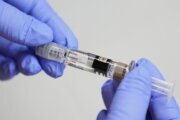Expectant mothers as well as women trying to get pregnant, and their partners, already have a lot to think about.
Experts recommend doing everything possible to be in optimal health, from exercising to eating right, as well taking a folic acid supplement to reduce the risk for birth defects like spina bifida. But one widespread threat to the health of the child that research is still sorting out — and which is far more difficult to control — is pollution.
“We recognize that the conditions in which women live are very important in terms of the outcomes of their health and the newborn baby’s health,” says Dr. Paul Jarris, chief medical officer for the March of Dimes, a nonprofit focused on improving the health of mothers and babies, including reducing preterm birth rates and infant mortality. “Pollution is a very ubiquitous thing, and there are things that both individuals can do — such as eliminating smoking or secondary air smoke — and there are things that we as society must do to limit the general air pollution that people are exposed to.”
The impact of pollution on the health of people directly exposed to it has been widely studied. Air pollution — like particulate matter, or extremely small particles and droplets, found in smoke — is blamed for everything from exacerbating asthma and other breathing and lung problems to raising cardiovascular risk. Now researchers are trying to get a better handle on how exposure to pollution during pregnancy — and in some cases, immediately before a woman becomes pregnant — can impact the health of the child.
[See: The Best and Worst Exercises for Pregnant Women.]
Janet Currie, a health economist and director of the Center for Health and Wellbeing at Princeton University, has been looking closely at how exposure to pollution during pregnancy might affect infant health. One big polluter: Idling cars are a problem particularly for people who live around toll plazas, where bottlenecks of running vehicles spew pollutants such as carbon monoxide and nitrous oxides. Past research Currie led on traffic congestion and infant health found the introduction of electronic toll collection using E-ZPass in New Jersey and Pennsylvania — which allowed cars to whiz through, rather than having to stop to pay a toll — was associated with a 40 percent reduction in carbon monoxide emissions and an 11 percent decrease in nitrous oxide emissions. “That had a positive effect on infant health,” she says. Namely, the incidence of babies being born at a low birth weight declined by 12 percent among mothers who lived within 2 kilometers (or about 1 1/4 miles) of a toll plaza. Exposure to air pollution during pregnancy can increase the risk of premature birth and a baby being born at a low birth weight, the March of Dimes notes on its website. The organization notes that “premature birth is birth that happens too soon, before 37 weeks of pregnancy. Low birth weight is when a baby is born weighing less than 5 pounds, 8 ounces.”
Low birth weight has been shown to raise the risk for issues ranging from infant mortality to asthma, and attention deficit hyperactivity disorder to lower marks in school. And a study published in The Journal of Pediatrics in December found a link between a woman’s exposure to a higher level of particulate matter — particularly in the month before and after conception — and a modest increase in the risk of having a baby with birth defects like cleft palate; “the potential impact on a population basis is noteworthy because all pregnant women have some degree of exposure” to particulate matter, the researchers noted .
Another recent study, which Currie led, evaluated the potential impact of hydraulic fracturing, or fracking — a method used to extract natural gas and oil that involves forcing water and chemicals into shale rock to fracture it — on infant health. With fracking, “because it’s a new industry … you can use that to try and identify the effects of being close to the pollution source. So I see it very much as being part of a program of research trying to look at the effects of pollution on infant health,” Currie says. The study was published in the journal Science Advances in December.
She and fellow researchers found there was an increase of about 25 percent in the incidence of low birth weight babies born to mothers living within one kilometer (about 0.6 miles) of fracking sites in Pennsylvania compared to mothers who live more than 3 kilometers (or more than about 2 miles) from a fracking site. “We found that living really close to one of these fracking sites had a significant and quite large negative effect,” she says. According to researchers’ estimates, about 29,000 infants in the U.S. were born to mothers living within one kilometer of an active fracking site within a year’s time (between July 2012 and 2013).
Researchers also found a decline in average birth weight of children, extending to women who lived from one to three kilometers from the fracking site. “We found evidence for negative health effects of in utero exposure to fracking sites within 3 km of a mother’s residence, with the largest health impacts seen for in utero exposure within 1 km of fracking sites,” the researchers note. No effects were found for people living farther than three kilometers away.
Among the study’s limitations is that it didn’t examine the mechanism, or what caused the negative health effects on infants. “The pathway of exposure was not a subject of our study and is not known with certainty,” the researchers noted. “The results of our study are consistent with the possibility that very local air pollution, perhaps from the multiple diesel generators used at well sites, from chemicals used in fracking, or even from truck traffic to and from sites, could be a potential key source of exposure.”
Industry officials contested the study’s findings. “This report highlights a legitimate health issue across America that has nothing to do with natural gas and oil operations,” the American Petroleum Institute, a trade association representing the oil and gas industry, said in a statement. “It fails to consider important factors like family history, parental health, lifestyle habits, and other environmental factors and ignores the body of scientific research that has gone into child mortality and birth weight.”
[See: 10 Weird Mind and Body Changes That Are Totally Normal During Pregnancy.]
Pollution Outside — and Inside — the Home
Health experts say it’s not just outdoor air pollution that’s of concern, either; indoor air pollution, ranging from carbon monoxide to radon, poses a threat, as well.
As researchers continue to try to better grasp how pollution might affect infant health, there are some things expectant moms and dads can do at home:
— Avoid not only smoking but secondhand and even what’s called thirdhand smoke: “That could include even having the smoke on people’s clothing, if they don’t smoke in front of a pregnant woman,” Jarris points out.
— If you’re concerned about high levels of outdoor pollution, keep the home sealed. If it’s hot outside, running air conditioning, rather than opening windows, may help — though it’s not foolproof, particularly in homes that aren’t so airtight.
— Use a carbon monoxide detector in your home, and make sure it’s always in good, working order. “Carbon monoxide is particularly toxic during pregnancy and to newborns,” Jarris notes.
— Have the home tested for lead, radon, mold and asbestos, he says. Call your local health department if you’re not sure where to start; and if you have any health concerns about pollution, tell your doctor. Among the threats, “Lead is a neurotoxin. So particularly for infants before birth and after birth when the brain is dramatically developing, that lead can be toxic to the development of the brain,” Jarris notes. “It can result in severe developmental delays … lowering the IQ and it can also result in lower ability to learn in the school [and] behavioral problems.”
When it comes to protecting infant health, the would-be father’s exposure to pollution should be considered, too. “It’s not just Mom’s preconception environment but Dad’s as well,” which should be taken into account, says Kaylon Bruner-Tran, a professor of obstetrics and gynecology at Vanderbilt University Medical Center.
It’s clear that where parents live — and work — matters when it comes to how pollution exposure leading up to or during pregnancy may affect an infant’s health, adds Kevin Osteen, professor of obstetrics and gynecology and director of the Women’s Reproductive Health Center at Vanderbilt University Medical Center.
[See: How to Cope With Gestational Diabetes.]
“You live where you live,” Jarris says — and many don’t have the financial wherewithal to simply move away from a major polluter. “One of the things that determines how much people get exposed to pollution is definitely their income,” Currie notes. Such limitations that make it more difficult to avoid or minimize pollution exposure is all the more reason, health experts say, the issue can’t be tackled solely by making individual changes but must be addressed on a societal level.
More from U.S. News
In Vitro Fertilization Grows Up
The Fertility Preservation Diet: How to Eat if You Want to Get Pregnant
The 11 Most Dangerous Places in Your Home for Babies and Small Kids
When Pollution Threatens the Health of the Baby on the Way originally appeared on usnews.com







